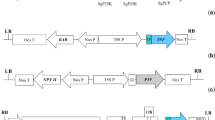Summary
An antiviral substance, showing highly significant virus inhibiting property, has been isolated from the aqueous extract ofCuscuta reflexa plants. The biologically active virus inhibitor was purified by fractionation with organic solvents followed by precipitation with a saturated solution of ammonium sulphate, dialysis, ultracentrifugation and filtration through a Sephadex G-200 column. It shows characteristics of proteins with a molecular weight around 14,000–18,000 daltons. The antiviral activity of the purified material was increased several folds. It has prevented the infection of several unrelated isometric as well as anisometric viruses in their hypersensitive and systemic hosts. Systemic resistance induced in lower treated as well as upper nontreated leaves of host plants, whose lower leaves had been treated with inhibitor, was significantly reversed in presence of Actinomycin D.
Similar content being viewed by others
References
Andrews, P.: Estimation of the molecular weights of proteins by Sephadex gel filtration. Biochem. J.91, 222–223 (1964).
Apablaza, G. E., Bernier, C. C.: Inhibition of tobacco mosaic virus infection by plant extracts. Canad. J. Bot.50, 1473–1478 (1972).
Awasthi, L. P.: Characteristics and mode of action of a virus inhibitor fromCuscuta reflexa plants. Arch. Virol. (communicated) (1981).
Bozarth, R. F., Ross, A. F.: Systemic resistance induced by localized virus infections: extent of changes in uninfected plant parts. Virology24, 446–455 (1964).
Gianinazzi, S., Kassanis, B.: Virus resistance induced in plants by polyacrylic acid. J. gen. Virol.23, 1–9 (1974).
Kassanis, B., White, R. F.: Inhibition of acquired resistance to tobacco mosaic virus by Actinomycin D. J. gen. Virol.25, 323–324 (1974).
Koch, F. C., Hankee, M. E.: Practical methods in biochemistry, 5th ed. Baltimore: The Williams and Wilkins Company 1948.
Loebenstein, G.: Further evidence on systemic resistance induced by localized necrotic virus infections in plants. Phytopathology53, 306–308 (1963).
Loebenstein, G., Rabina, S., Van Praagh, T.: Sensitivity of induced localized acquired resistance to actinomycin D. Virology34, 264–268 (1968).
Loebenstein, G.: Localization and induced resistance in virus infected plants. Ann. Rev. Phytopathol.10, 177–206 (1972).
Loring, H. S.: The reversible inactivation of tobacco mosaic virus by crystalline ribonuclease. J. gen. Physiol.25, 497–505 (1942).
Lowry, O. H., Rosebrough, N. J., Farr, A. L., Randall, R. J.: Protein measurements with the Folin phenol reagent. J. biol. Chem.193, 265–275 (1951).
McKeen, C. D.: The inhibitory activity of extract ofCapsicum frutescens on plant virus infections. Canad. J. Bot.34, 891–903 (1956).
Ragetli, H. W. J.: Behaviour and nature of virus inhibitor occurring inDianthus caryophyllus L. Tijdschr. Plantenziekten61, 245–344 (1957).
Randerath, K.: Thin layer chromatography. New York: Academic Press 1963.
Reich, E., Goldberg, I. H.: Actinomycin and nucleic acid function. Progr. Nucleic Acid Res.3, 183–234 (1964).
Ross, A. F.: Localized acquired resistance to plant virus infection in hypersensitive hosts. Virology14, 329–339 (1961).
Ross, A. F.: Systemic acquired resistance induced by localized virus infections in plants. Virology14, 340–358 (1961).
Ross, A. F.: Systemic effects of local lesion formation. In:Beemster, A. B. R., Dijkstra, J. (eds.), Viruses of plants, 127–150. Amsterdam: North-Holland Publishing Company 1966.
Sänger, H. L., Knight, C. A.: Action of actinomycin D on RNA synthesis in healthy and virus-infected tobacco leaves. Biochem. Biophys. Res. Commun.13, 455–461 (1963).
Smookler, M. M.: Properties of inhibitors of plant virus infection occurring in the leaves of species in the chenopodiales. Ann. Appl. Biol.69, 157–168 (1971).
Taniguchi, T., Goto, T.: Purification of an inhibitor of plant virus infection occurring in leaves ofChenopodium amaranticolor. Ann. Phytopathol. Soc. Japan42, 42–45 (1976).
Verma, H. N., Awasthi, L. P.: Prevention of virus infection and multiplication by leaf extract ofEuphorbia hirta and the properties of the virus inhibitor. New Bot.6, 49–59 (1979).
Verma, H. N., Awasthi, L. P.: Antiviral activity ofBoerhaavia diffusa root extract and the physical Properties of the virus Inhibitor. Canad. J. Bot.57, 926 to 932 (1979).
Verma, H. N., Awasthi, L. P.: Occurrence of a highly antiviral agent in plants treated withBoerhaavia diffusa inhibitor. Canad. J. Bot.58, 2141–2144 (1980).
Verma, H. N., Awasthi, L. P., Mukerjee, K.: Characteristics and mode of action of natural inhibitors of virus infection. In:Misra, P. C. (ed.), Vistas in mycology and plant pathology, published by Prof. K. S. Bhargava's 60th Birth Anniversary Felicitation Committee, Gorakhpur University, India (1979).
Verma, H. N., Awasthi, L. P., Saxena, K. C.: Isolation of the virus inhibitor from the root extract ofBoerhaavia diffusa inducing systemic resistance in plants. Canad. J. Bot.57, 1214–1217 (1979).
Verma, H. N., Mukerjee, K.: Brinjal leaf extract induced resistance to virus infection in plants. Ind. J. expt. Biol.13, 416–417 (1975).
Verma, H. N., Mukerjee, K., Awasthi, L. P.: Determination of molecular weight of a polypeptide inducing resistance against viruses. Naturwissenschaften67, 364 (1980).
West, E. S., Todd, W. R., Mason, H. S., Van Bruggen, J. T.: Text Book of biochemistry, 4th ed. New York: Macmillan 1966.
White, R. F.: Acetylsalicylic acid (asprin) induces resistance to tobacco mosaic virus in tobacco. Virology99, 410–412 (1979).
Wyatt, S. D., Shepherd, R. J.: Isolation and characterisation of a virus inhibitor fromPhytolacca americana. Phytopathology59, 1787–1794 (1969).
Author information
Authors and Affiliations
Additional information
With 3 Figures
Rights and permissions
About this article
Cite this article
Awasthi, L.P. The purification and nature of an antiviral protein fromCuscuta reflexa plants. Archives of Virology 70, 215–223 (1981). https://doi.org/10.1007/BF01315128
Received:
Accepted:
Issue Date:
DOI: https://doi.org/10.1007/BF01315128




